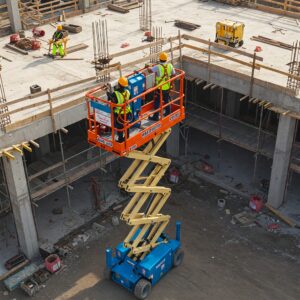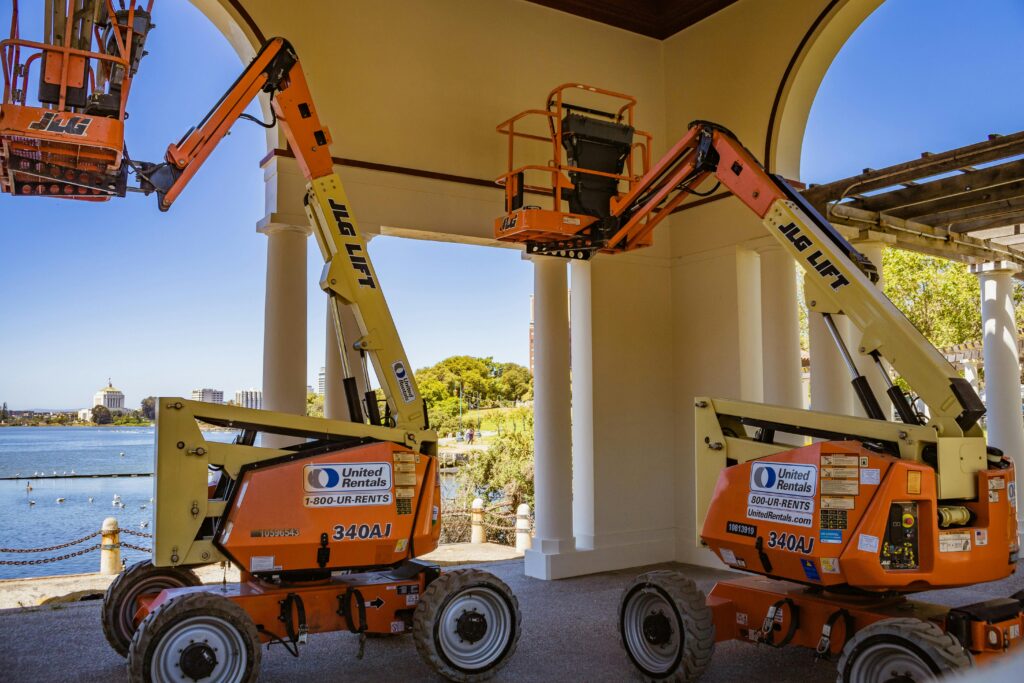In industries like construction, maintenance, and warehousing, working at height is often a necessity. Whether it’s repairing a building facade, installing lighting, or accessing hard-to-reach areas, a Mobile Elevated Working Platform (MEWP) is an indispensable tool. MEWPs, also known as aerial work platforms or cherry pickers, provide a safe and efficient way to perform tasks at height. In this blog post, we’ll explore what MEWPs are, their types, benefits, safety considerations, and how to choose the right one for your needs.

What is a Mobile Elevated Working Platform (MEWP)?
A Mobile Elevated Working Platform (MEWP) is a mechanical device used to lift workers, tools, and materials to elevated work areas. Unlike traditional scaffolding or ladders, MEWPs are mobile, versatile, and designed to enhance safety and productivity. They come in various shapes and sizes, from compact scissor lifts to boom lifts with extendable arms.
MEWPs are commonly used in:
- Construction sites
- Warehouses and factories
- Maintenance and repair work
- Event setups
- Tree trimming and landscaping
Types of Mobile Elevated Working Platforms
MEWPs are categorized based on their design and functionality. Here are the most common types:
1. Scissor Lifts
Scissor lifts are ideal for tasks that require vertical elevation. They feature a crisscrossing metal framework that extends upward, providing a stable platform for workers. Scissor lifts are commonly used indoors, such as in warehouses or for ceiling repairs.
2. Boom Lifts
Boom lifts, also known as cherry pickers, have an extendable arm that can reach over obstacles. They are perfect for tasks that require both height and horizontal reach, such as window cleaning or tree trimming. Boom lifts come in two varieties:
- Articulating Boom Lifts – Flexible arms that can bend and maneuver around obstacles.
- Telescopic Boom Lifts – Straight arms that extend to greater heights.
3. Vertical Mast Lifts
Vertical mast lifts are compact and designed for tight spaces. They provide vertical elevation but lack the horizontal reach of boom lifts. These are often used for indoor maintenance tasks.
4. Spider Lifts
Spider lifts are lightweight and designed for uneven or challenging terrains. They feature stabilizers and can be used both indoors and outdoors.
5. Truck-Mounted Platforms
These MEWPs are mounted on trucks, making them highly mobile and suitable for outdoor tasks like streetlight maintenance or bridge inspections.
Benefits of Using a Mobile Elevated Working Platform
MEWPs offer numerous advantages over traditional methods of working at height. Here’s why they are a popular choice:
1. Enhanced Safety in Mobile Elevated Working Platform
MEWPs are equipped with safety features like guardrails, harness points, and emergency lowering systems. They provide a stable and secure platform, reducing the risk of falls and accidents.
2. Increased Productivity
With a MEWP, workers can quickly and easily access elevated areas, saving time and effort. This increased efficiency leads to quicker project completion and significant cost savings.
3. Versatility
MEWPs are available in various types and sizes, making them suitable for a wide range of tasks and environments.
4. Mobility
Unlike fixed scaffolding, MEWPs are mobile and can be easily moved around a worksite. This flexibility is especially useful for large or multi-location projects.
5. Cost-Effective
While the initial investment in a MEWP may be high, the long-term savings in labor, time, and reduced risk of accidents make it a cost-effective solution.
Safety Considerations for Using MEWPs
While MEWPs are designed to enhance safety, improper use can lead to accidents. Here are some essential safety tips:
1. Training and Certification
Operators must be trained and certified to use MEWPs. Proper training ensures they understand the equipment’s controls, limitations, and safety protocols.
2. Pre-Use Inspections
Before using a MEWP, conduct a thorough inspection to check for any mechanical issues or damage. Look for leaks, worn-out parts, or malfunctioning controls.
3. Stability and Load Capacity
Ensure the MEWP is on a stable surface and within its load capacity. Overloading or using the platform on uneven ground can lead to tipping or collapse.
4. Fall Protection
Workers should always wear a harness and attach it to the designated anchor points on the MEWP. Guardrails should also be in place to prevent falls.
5. Avoid Overreaching
Overreaching from the platform can cause the MEWP to become unstable. Always reposition the platform instead of stretching beyond its limits.
6. Weather Conditions
Avoid using MEWPs in adverse weather conditions like strong winds, rain, or lightning, as these can compromise safety.
7. Emergency Procedures
Ensure operators know how to lower the platform manually in case of a power failure or mechanical issue.
How to Choose the Right Mobile Elevated Working Platform
Selecting the right MEWP for your project is crucial for safety and efficiency. Here are some factors to consider:
1. Height and Reach Requirements
Determine the maximum height and horizontal reach needed for your tasks. Choose a MEWP that meets these requirements with some extra capacity for flexibility.
2. Worksite Conditions
Consider the terrain and space available at your worksite. For example, spider lifts are ideal for uneven terrain, while scissor lifts are better suited for indoor use.
3. Load Capacity
Calculate the combined weight of workers, tools, and materials to ensure the MEWP can handle the load safely.
4. Power Source
MEWPs can be powered by electricity, diesel, or hybrid systems. Electric MEWPs are quieter and emission-free, making them ideal for indoor use, while diesel MEWPs are better for outdoor tasks.
5. Mobility and Transport
If you need to move the MEWP between sites, consider its size and weight. Truck-mounted platforms are highly mobile, while larger MEWPs may require special transport arrangements.
6. Budget
Ensure that your budget aligns with the necessary features and capabilities to make the most cost-effective choice. Renting a MEWP can be a cost-effective option for short-term projects.
The Future of MEWPs
As technology advances, MEWPs are becoming smarter and safer. Innovations like remote control operation, advanced sensors, and telematics are transforming the way MEWPs are used. These features enhance safety, improve efficiency, and provide real-time data on equipment performance.
Conclusion
A Mobile Elevated Working Platform (MEWP) is an essential tool for any task that requires working at height. By choosing the right MEWP and following safety guidelines, you can ensure a safe, efficient, and productive work environment. Whether you’re working on a construction site, maintaining a warehouse, or setting up an event, a MEWP can make your job easier and safer.
Investing in proper training, regular maintenance, and high-quality equipment will not only protect your workers but also improve your bottom line. So, the next time you have a project that involves working at height, consider the benefits of a mobile elevated working platform and make safety your top priority.
Read this also : Top Safety Tips for Working at Height.


